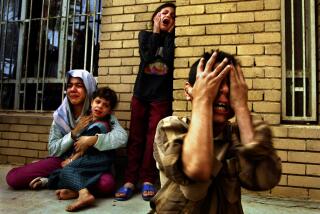TROOPS SCORE SMALL VICTORIES
- Share via
Combat Outpost War Eagle, Iraq — The high-value target was shacked up with a prostitute.
That, at least, was the story provided by an Iraqi man who approached this combat outpost dug into the muddy east bank of the Tigris River in Baghdad. The target was Usama Kokez, a Sunni accused of leading a kidnapping ring that had executed several Shiite civilians.
The tip sent 1st Lt. Larry Pitts and his troops on a wild dash through the dark streets of Adhamiya in northwest Baghdad, their night-vision goggles on and their headlights off. For a battalion of 82nd Airborne paratroopers that is part of the “surge” of 21,500 troops being dispatched to stabilize Baghdad and Al Anbar province to the west, the Kokez tip was one small return on an investment.
The unit had been hiking down garbage-strewn streets for three weeks, imploring Iraqis to provide information on insurgents and militias in Shiite and Sunni neighborhoods. Such boots-on-the-ground probing is a staple of counterinsurgency warfare, but it was scrapped several months after U.S.-led forces invaded Iraq in 2003. Now it has been revived in the face of a rampant insurgency and a devastating sectarian war.
“The difference this time is, we’re not leaving,” said Army Maj. Gen. William B. Caldwell IV, the top U.S. military spokesman in Iraq.
Most of the additional troops aren’t on massive, fortified bases. They live beside Iraqi soldiers on small, urban combat outposts such as War Eagle, or with Iraqi police in even smaller joint security stations, in a bid to win over the population by providing round-the-clock security.
Fifteen joint security stations have been set up, with a goal of establishing 28 to 30, the military says. Officials, citing security concerns, refuse to reveal the number and location of combat outposts.
Nearly four years into the war, U.S. forces are still introducing themselves to Iraqis. Residents of some areas assigned to Pitts’ unit have never seen American soldiers in their neighborhoods.
None of that mattered to Pitts, a calm, resolute veteran of three Iraq tours. Known as Big Larry, he prefers the streets to the bases. He and his soldiers have been passing out “tip cards” to Iraqis. The cards ask for information on insurgents and militias and provide a phone number for the combat outpost.
Pitts, 32, beefy and barrel-chested, is a genial ambassador. With his round, open face and earnest manner, he is able to approach people in their doorways without terrifying them. Through a masked interpreter nicknamed Phillip, he chatted amiably on a recent mission, cajoling and politicking.
Residents complained about gunmen terrorizing the Fish Market, a local bazaar shaped like a fish. Just after Pitts and his troops returned to their outpost in the afternoon, a local man showed up and said Kokez was at home with a prostitute. He provided an address near the market.
A high-tech effort
For the next two hours, the full technological weight of the U.S. military was brought to bear against Usama Kokez. The plan called for a Shadow spy drone, an F-16 jet and an Apache attack helicopter to circle overhead. They would provide real-time video feeds projected on a wall and on laptops in an operations center inside a former Iraqi police gymnasium.
Computer screens inside Humvees displayed maps of the target area. Other imagery was overlaid with schematics showing positions for the assault team and cordons of troops.
Databases spat out other Iraqi complaints and intelligence details about Kokez, whom the military had been seeking for weeks. No raid is launched without multiple sources implicating a suspect, said the battalion commander, Lt. Col. Wilson Shoffner.
Kokez was a prized quarry. According to battalion officers, he had joined Al Qaeda against his father’s wishes. Either he or his brother Amar, also an alleged Al Qaeda member, killed the father in order to join, the officers said.
A phalanx of Humvees carrying 58 soldiers from Bravo battery, known as the Bulls, sped through the streets, deserted because of the city’s overnight curfew. In the back of one Humvee sat the Iraqi informant, his face masked. Next to him was a masked interpreter nicknamed Bob.
The Kokez compound consisted of three connected homes behind gated walls, difficult to distinguish on satellite imagery.
The assault team, in full combat armor with automatic rifles and shotguns, burst from their vehicles -- and stormed the wrong house.
They bashed the outer metal gate with a crowbar-like device known as a hooligan tool, but it held fast. It took five shotgun blasts to blow off the locks and hinges.
During the delay, pilots overhead -- and officers watching video feeds at the outpost -- saw a man race across a rooftop next door, leap a fence and bolt down an alley.
Inside his Humvee, the informant gestured wildly toward a second house. “He says that’s the right house!” the interpreter screamed.
One small victory
The assault team crashed through the front gate and door. In the half-lighted living room were three frightened women and two squalling infants. Questioned by Spc. Andrea Pierce, 21, an intelligence soldier, the women at first said they had never heard of Usama Kokez.
“Stop lying to me!” Pierce yelled, her face flushed beneath her helmet.
Ultimately, the women admitted that Kokez lived there. In fact, they were hardly prostitutes, as the informant claimed. They were Kokez’s wife, sister and mother.
Pierce hauled Kokez’s wife, Rhagad, 22, into a side room and strip-searched her. The woman was wearing two bras. Tucked inside were two 9-millimeter pistol ammunition magazines and a cellphone. Inside her panties was a second cellphone, Pierce said.
In the alley behind the house, barely visible in the shadows, Sgt. Billy Davidson’s Humvee formed part of the security cordon. A barefoot man in a dark tracksuit tumbled over a wall and landed next to the vehicle.
Davidson and two other soldiers piled out and pointed their M-4 automatic rifles at him. The man said something in Arabic. Davidson told him in English to shut up and get on his belly.
“He was crying like a baby,” Davidson said later.
In the man’s pocket was a firecracker and an ID card. It was Usama Kokez.
Kokez, 29, lean and curly-haired, was cuffed and blindfolded. The cellphones and ammo clips were later put inside plastic bags and strung around his neck to be photographed as evidence.
Inside the house, his sister, Nakm Kokez Alwan, let out a high-pitched wail that pierced the night. She cursed the soldiers and screamed, “You have destroyed my family!”
Usama Kokez said only, “Take care of my wife and children.”
If Kokez was indeed a leader of a kidnapping and killing cell, his arrest was one small victory in the battalion’s attempt to bring security to Adhamiya. More important, interrogation and the numbers obtained from the cellphones led intelligence teams to other alleged insurgents.
“We would never get this kind of intel if we didn’t go out on the street, talking to people every day, showing them that we’ll do something if they’ll just help us with information,” Pitts said.
Soldiers in the unit, the 2nd Battalion of the 319th Airborne Field Artillery Regiment, are uncomfortable discussing the three years U.S. forces spent largely hunkered down inside the big bases. They are reluctant to criticize an earlier strategy that assumed U.S. soldiers stationed in neighborhoods were magnets for insurgent attacks, contributing to violence rather than quelling it.
But many among the 350 soldiers at the outpost said they felt energized and productive out on the streets.
“I completely buy into ‘Fight where you live, live where you fight,’ ” said Capt. Jon Harvey, 31, who commanded the Kokez raid.
An absence of Iraqis
Conspicuously missing from the raid were Iraqi police and troops. For all the talk about turning over security to Iraqi forces so Americans can eventually leave, U.S. commanders run the show in Adhamiya.
The Iraqi police force is dominated by Shiite militiamen, some of whom run death squads targeting Sunnis, and it is riddled with insurgent informants. The Iraqi army, despite a few competent units, is poorly led, undisciplined and dependent on the U.S. for such basics as transportation and communications.
“We can roll up all the bad guys you want, but we won’t succeed without the Iraqis,” Lt. Col. Shoffner said. “The goal is less U.S. and more Iraqis.”
And despite the buildup of troops, the U.S. lacks the force that its own counterinsurgency manuals say is required to effectively combat an insurgency in a country the size of Iraq. The 82nd Airborne brigade assigned to northwest Baghdad has 3,000 troops for 2.4 million Iraqis.
But day after day, Big Larry and his Bulls walked down the narrow streets, trailed by boisterous children. In full combat gear and carrying automatic weapons, scanning rooftops from behind dark sunglasses, they seemed alien and intimidating.
Some young men stared balefully, and other residents recoiled when offered the tip cards. But others approached the soldiers to offer information on gunmen, and several invited the soldiers into their homes to talk privately.
A schoolteacher who gave his name as Ibrahim provided information on the Fish Market killers and said, in English, “When I see the American Army, I feel safe.”
Three days after the Kokez raid, a young man from the neighborhood called the number on the tip card. He said Amar Kokez was inside a house near his brother’s place.
The young man said he came forward because a friend had been killed by insurgents, and because he had been heartened by the earlier raid. Three other sources had previously linked Kokez to an insurgent cell, Capt. Harvey said.
Because this was a “time-sensitive target,” planning was rapid. The tip came in at 7:30 p.m. By 9 p.m., the raiding party was picking up the informant under a deserted bridge en route to Kokez’s house.
Three shotgun blasts crumpled the front gate. The assault team found Kokez and his wife on a bed, their freshly cooked dinner of roast meat and salad spread before them.
Kokez, a slender man with a thin black mustache, was forced to the floor, cuffed and blindfolded. A sergeant knelt down to interrogate him, shining a light into his face. Amar began to weep softly.
“Oh, you’re gonna cry now?” the sergeant said, mocking him.
For the next 15 minutes, the sergeant bore down on Kokez. Threatening and pleading, he coaxed a steady flow of information. Kokez provided names of men he said were planning kidnappings and killings. He told the sergeant where they lived, near the Fish Market, and the market store where they planned their attacks.
Combined with the arrest of his brother, the capture of Amar Kokez was an incremental triumph in the military’s attempt to show residents that cooperation can lead to arrests and, ultimately, more security.
An hour later, the assault team was back at the combat outpost. There, Kokez’s interrogation results and his cellphone information were fed into a growing intelligence database. And in a back room, Capt. Harvey shook the young informant’s hand and called him an Iraqi patriot.
More to Read
Sign up for Essential California
The most important California stories and recommendations in your inbox every morning.
You may occasionally receive promotional content from the Los Angeles Times.













